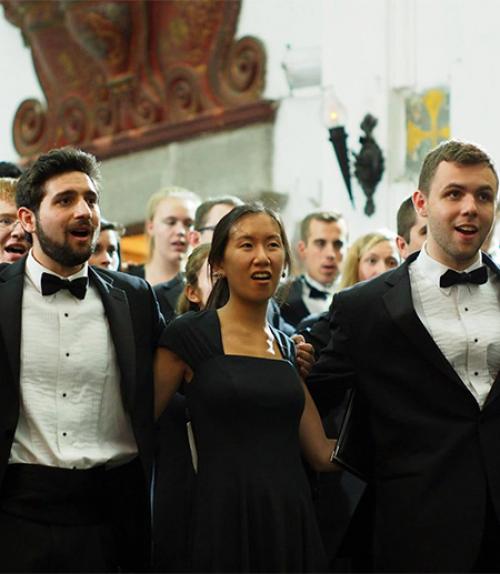As the Cornell Chorus and Glee Club meandered through Guatemala and Mexico during their three-week winter break tour, they filled churches, sang at orphanages, worked with college-age musicians and even spent a day making a professional studio recording.
More than two years in the making, the tour included 96 students, along with director Robert Isaacs and assistant conductor Steve Spinelli. Roberto Sierra – professor and chair of composition in the music department and composer of “Cantares,” a piece the Glee Club and Chorus commissioned for Cornell’s sesquicentennial celebration – also made the trip to Mexico to hear that piece performed and recorded.
“We think of ourselves as a professional group in everything that we do,” said Jacob Cohen ’16, past Glee Club president and one of four student tour managers. “But during the recording, we were absolutely treated as peers with the orchestra and the other musicians.”
Students should hear a first cut of that recording in a few weeks.
The group landed in Guatemala Jan. 6, singing its first a cappella concert to a packed church of 1,400 people, said Amy Penick ’17, a chorus member and student tour manager.
“The whole community came out,” she said. “People were very excited to have an American group perform.”
After touring a coffee plantation, climbing up a slightly erupting volcano and hosting several workshops and concerts in Guatemala, the groups chartered a plane (it’s cheaper than buying 98 tickets separately, they found out) to fly to Mexico.
There they performed eight more concerts, including one at the Cornell Club in Mexico City and their final show Jan. 22 with the Xalapa Symphony Orchestra, which also joined them for the “Cantares” recording.
For each concert, Isaacs chose a different repertoire of pieces based on this year’s theme of transformation – some pieces for both groups together and some for either Glee Club or Chorus. Many of the pieces featured other languages, particularly Spanish.
“We thought it was important for each group to sing at least one piece in Spanish during each concert,” Isaacs said. “And we also included a piece that was one of Roberto Sierra’s inspirations for ‘Cantares.’”
That 17th-century piece, “Hanacpachap Cussicuinin,” written in Quechua, is one of the first polyphonic pieces of music that survived from the Americas, Isaacs said.
“It has a certain kind of earthy quality that we found ourselves reaching for,” Isaacs said, especially when the group broke into song as they traveled about, at the top of the volcano, for example.
Although planning a tour like this one is something many college choirs farm out to a professional agency, the Chorus and Glee Club are entirely student-run.
“Part of our identity is based on what we contribute,” said Nathan Kashdan ’18, another tour manager. “All of our management and all of our fund-raising are one by the students.”
All of the students were quick to chime in that the tour would be impossible without alumni support. Their various school visits, outreach events and concerts were organized with the help of Cornell alumni who live in the regions they visited, and with the help of Cornell alumni affairs officers.
The groups raised $120,000 in six months for the trip, ensuring that “no singer was left behind,” said Adam Proch ’17, another tour manager. They were also helped by a Cornell crowd-funding campaign and housing subsidies or donations from School of Hotel Administration alums.
“There was no chance we could have gone on this tour without alumni support,” said Cohen, adding that all of their goals for the trip were realized – for students to have a rich cultural experience, act as ambassadors for Cornell, and share their musical and artistic passions with others.
During one of the many workshops held with local children, Isaacs gave a brief conducting lesson to a 4-year-old volunteer, explaining that Chorus and Glee Club members would sing for as long as he kept his hand opened and stop when it was closed.
Penick said she was moved watching the boy realize he possessed the power to make the music stop and go.
“I’ve run many workshops around the world with the hope of inspiring young people to get involved in music,” Isaacs said. “It’s so much easier when you have 100 role models standing right behind you.”
Kathy Hovis is a writer for the College of Arts and Sciences.
(photo courtesy of La Merced Church)




